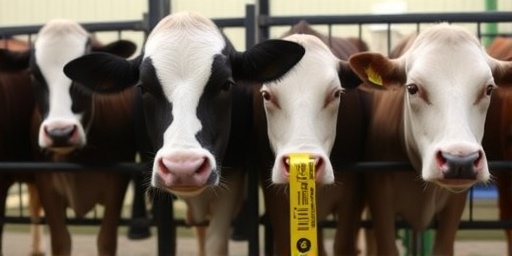In a alarming development for the U.S. dairy industry, highly pathogenic avian influenza, commonly known as Bird flu or H5N1, has been confirmed in dairy cows across California farms. The U.S. Department of Agriculture (USDA) announced the detections on Friday, triggering immediate quarantine measures for affected herds and heightened milk testing protocols to safeguard public health and prevent further spread.
- California Central Valley Farms First to Report H5N1 Symptoms
- USDA Imposes Strict Quarantine on Infected Herds and Traces Contacts
- Milk Pasteurization Shields Consumers Amid Rigorous Testing Surge
- Health Experts Monitor for Human Spillover as Virus Evolves
- Dairy Industry Braces for Economic Ripples and Future Preparedness
The cases mark the first confirmed instances of H5N1 in dairy cows within the Golden State, raising concerns amid an ongoing national outbreak that has already impacted cattle in eight other states. While no human infections have been reported in connection with these California cases, officials are urging vigilance as the virus continues to evolve.
California Central Valley Farms First to Report H5N1 Symptoms
The outbreak was first detected in dairy operations in Fresno and Tulare counties, two of California’s premier milk-producing regions. State veterinarians identified clinical signs consistent with H5N1 infection, including reduced milk production, lethargy, and respiratory distress in affected dairy cows. Laboratory tests conducted by the California Department of Food and Agriculture (CDFA) and confirmed by the USDA’s National Veterinary Services Laboratories verified the presence of the virus.
“We received reports from multiple farms showing unusual symptoms in their herds,” said Dr. Annette Jones, CDFA State Veterinarian. “Rapid testing confirmed H5N1, prompting us to notify the USDA immediately for coordinated action.”
According to preliminary data, at least three herds totaling over 1,200 cows have been impacted. Symptoms appeared as early as mid-October, but confirmation came after enhanced surveillance protocols were activated following outbreaks in neighboring states. The virus, typically associated with wild birds and poultry, has shown a remarkable ability to jump to mammals, including cattle, since its detection in U.S. dairy cows earlier this year.
- Affected counties: Fresno, Tulare, with monitoring in Kern and Stanislaus.
- Herd sizes: Ranging from 300 to 600 cows per farm.
- Symptom onset: Decreased lactation by up to 40%, fever, and nasal discharge.
Farmers in the Central Valley, which accounts for nearly 40% of California’s $7.5 billion annual milk production, expressed shock but praised the swift response. “We’ve dealt with droughts and feed costs, but Bird flu in cows is uncharted territory,” said dairy farmer Maria Gonzalez of Tulare Dairy Farms.
USDA Imposes Strict Quarantine on Infected Herds and Traces Contacts
The USDA’s Animal and Plant Health Inspection Service (APHIS) wasted no time, issuing quarantine orders for all confirmed and suspect premises. Movement of cattle, milk, equipment, and personnel is now restricted, with depopulation recommended for severely affected animals to halt transmission.
Under the quarantine protocols:
- Infected herds must be isolated, with no animals leaving the premises until cleared.
- Surveillance testing on adjacent herds within a 3-mile radius.
- Trace-back investigations for animal movements in the past 30 days.
- Enhanced biosecurity audits, including footwear disinfection and wild bird deterrents.
USDA Secretary Tom Vilsack emphasized the agency’s preparedness: “Our nationwide response plan for H5N1 in cattle has been battle-tested in Texas, Michigan, and elsewhere. California’s quarantine is part of a unified strategy to contain this virus before it disrupts more farms.”
Since March 2024, H5N1 has infected over 880 dairy herds across 16 states, with California now joining the list. The USDA has allocated $1 billion in emergency funding for indemnity payments to farmers culling infected animals and implementing biosecurity upgrades.
Milk Pasteurization Shields Consumers Amid Rigorous Testing Surge
Public health officials moved quickly to reassure consumers about milk safety. The FDA and CDFA confirmed that pasteurization effectively kills H5N1, rendering commercial milk supplies safe. However, raw milk from affected farms has been diverted or destroyed.
California, the nation’s top dairy producer with 1.8 million cows generating 40 billion pounds of milk annually, has ramped up testing:
- Daily bulk tank milk sampling from quarantined herds.
- PCR and antigen tests on pooled samples for early detection.
- Traceback to processing plants, with no contaminated milk entering the market.
“We’ve tested over 5,000 milk samples statewide this month alone, and only these quarantined herds show positives,” reported Dr. Sarah Klein, FDA Dairy Safety Director. Retail milk prices have ticked up 2-3% in response to supply concerns, but experts predict minimal long-term impact if containment succeeds.
Consumer advisories urge avoiding raw milk products, which pose higher risks. The CDC notes that while H5N1 has caused mild human illnesses in farm workers elsewhere—mostly conjunctivitis—no severe cases or person-to-person spread have occurred.
Health Experts Monitor for Human Spillover as Virus Evolves
Despite no human cases tied to California’s outbreak, the CDC and state health departments are on high alert. H5N1, part of the influenza A family, has a high mortality rate in birds (up to 100%) but milder effects in cattle and rare human infections.
Globally, H5N1 has caused 889 human cases since 2003, with 463 deaths (52% fatality), per WHO data. In the U.S., 47 human cases linked to dairy or poultry exposure have been reported since 2024, all mild.
“The risk to the general public remains low, but workers handling sick animals should use PPE,” advised CDC Director Dr. Mandy Cohen. California has distributed 10,000 doses of H5N1 vaccine to at-risk groups and launched contact tracing for farm employees.
Genomic sequencing of California isolates shows the D1.1 genotype, matching strains in other U.S. cattle outbreaks, suggesting wild bird migration as the likely vector.
Dairy Industry Braces for Economic Ripples and Future Preparedness
The timing couldn’t be worse for California dairies, already strained by high feed costs and labor shortages. Industry groups like the California Dairy Campaign estimate potential losses of $50-100 million if quarantines expand, factoring in lost production and culling costs.
Western United Dairymen CEO Rob Vandenheuvel warned, “This Bird flu threat could shave 5% off our output if not contained swiftly. We’re pushing for federal aid and research into cattle vaccines.”
Looking ahead, the USDA plans expanded surveillance, including wastewater monitoring and wild bird testing along Pacific flyways. Long-term strategies include developing a cattle-specific H5N1 vaccine, currently in Phase 2 trials, with USDA approval eyed for 2026.
Lessons from 2024’s multi-state outbreak—involving rapid quarantines and farmer education—have bolstered response capabilities. As winter migration peaks, officials anticipate more detections but remain optimistic about containment. “We’ve contained worse in poultry; cattle won’t be different,” affirmed USDA’s Dr. Mark Abraham.
Stakeholders call for unity: enhanced farm biosecurity, consumer education on pasteurized products, and sustained funding. With vigilant monitoring, California’s dairy sector aims to weather this H5N1 storm and emerge more resilient.









